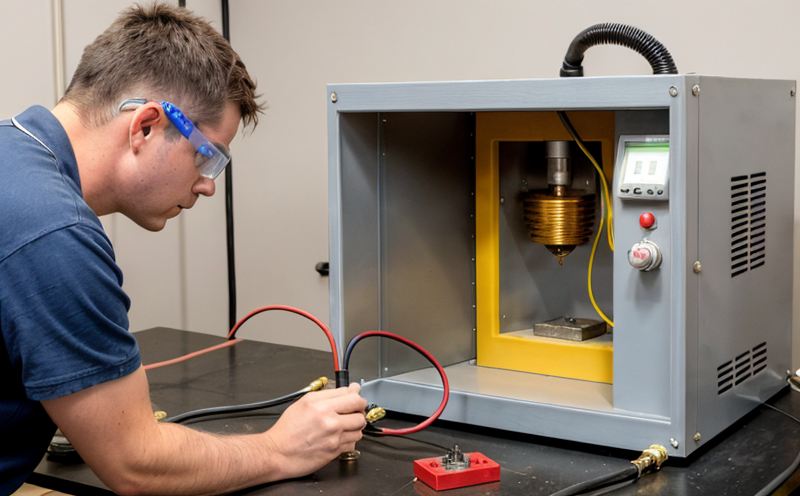ASTM A596 Magnetic Loss of Electrical Steels
The ASTM A596 standard is specifically designed to evaluate the magnetic properties and electrical conductivity of electrical steels, particularly those used in transformers and other electrical equipment. This test is crucial for ensuring that materials meet stringent performance criteria required by industry standards.
Electrical steels are subject to rigorous testing because they must exhibit minimal losses when subjected to alternating electromagnetic fields. The ASTM A596 test measures the magnetic permeability (μ) of the material, which quantifies how much a substance enhances or reduces the strength of an applied magnetic field. This metric is essential in optimizing energy efficiency and reducing heat generation within electrical devices.
The testing process involves subjecting samples to specific frequencies and amplitudes of alternating current. The sample’s resistance to changing fields is then measured, providing insights into its suitability for use in high-frequency applications like transformers or motors. Compliance with ASTM A596 ensures that the material not only meets but exceeds expectations regarding electrical performance.
Accurate measurement requires precise control over environmental factors such as temperature and humidity, which can significantly influence test results. Laboratories adhering to this standard ensure consistent and reliable outcomes by maintaining stringent quality controls throughout every step of sample preparation and analysis.
In summary, ASTM A596 provides a robust framework for evaluating the magnetic properties of electrical steels, offering valuable information about their suitability for various applications. By adhering strictly to this protocol, manufacturers can produce products that are both efficient and reliable, contributing positively to overall product quality assurance efforts within the metallurgy sector.
Industry Applications
The ASTM A596 test finds extensive application across numerous industries where electrical steels play a critical role. For instance, in the power generation sector, transformers made from materials compliant with this standard help minimize energy losses during transmission processes. This translates directly into reduced operational costs and improved environmental performance.
In manufacturing environments, ensuring that components used in motors or generators meet ASTM A596 specifications is essential for maintaining optimal machine efficiency. Compliance helps prevent costly downtime due to equipment failures caused by substandard materials.
The automotive industry also benefits from rigorous testing according to ASTM A596 since magnetic loss properties directly impact the performance and lifespan of key components such as starters and alternators. By selecting steels that pass this test, auto manufacturers can enhance vehicle reliability while reducing fuel consumption and emissions.
Additionally, renewable energy sources like wind turbines rely heavily on electrical steels for their efficient operation. Testing these materials against ASTM A596 standards guarantees consistent performance across different environmental conditions, thereby supporting sustainable power generation initiatives worldwide.
In each of these applications, adherence to ASTM A596 ensures that manufacturers produce high-quality products capable of meeting current and future demands set by regulatory bodies and market expectations alike.
Customer Impact and Satisfaction
Implementing ASTM A596 testing offers significant benefits for customers seeking reliable electrical steels. By ensuring compliance with this standard, suppliers can demonstrate their commitment to delivering top-tier products that consistently meet or exceed industry expectations. This approach fosters trust among clients who value quality above all else.
Clients in the power generation sector appreciate the assurance provided by ASTM A596-compliant materials because they know these components will perform reliably under demanding operating conditions. Similarly, manufacturers of automotive parts benefit from knowing that their suppliers adhere to stringent testing protocols, leading to more durable and efficient end products.
For renewable energy providers, selecting steels based on ASTM A596 results enhances the overall efficiency and longevity of wind turbine systems. This not only reduces maintenance costs but also contributes positively towards achieving long-term sustainability goals.
In summary, implementing ASTM A596 testing helps establish a culture of excellence within supply chains, ultimately driving customer satisfaction through consistently high-quality offerings.
Environmental and Sustainability Contributions
The use of ASTM A596-compliant electrical steels has far-reaching implications for environmental sustainability. By minimizing magnetic losses during operation, these materials contribute significantly to reducing energy consumption across various sectors, including power generation and transportation.
In the context of renewable energy installations such as wind farms, employing steels that pass ASTM A596 tests allows for greater efficiency in capturing and converting wind energy into electricity. This leads to lower carbon footprints associated with producing electrical power from natural resources.
For automotive manufacturers, using materials that meet these standards enables them to design lighter vehicles without compromising structural integrity or performance capabilities. Such innovations help decrease fuel consumption rates and promote greener travel options for consumers worldwide.
Beyond immediate operational efficiencies, the long-term effects of adhering to ASTM A596 guidelines include reduced waste generation during manufacturing processes and extended product lifecycles due to enhanced durability. These factors collectively form part of a broader strategy aimed at fostering eco-friendly practices throughout supply chains and beyond.





